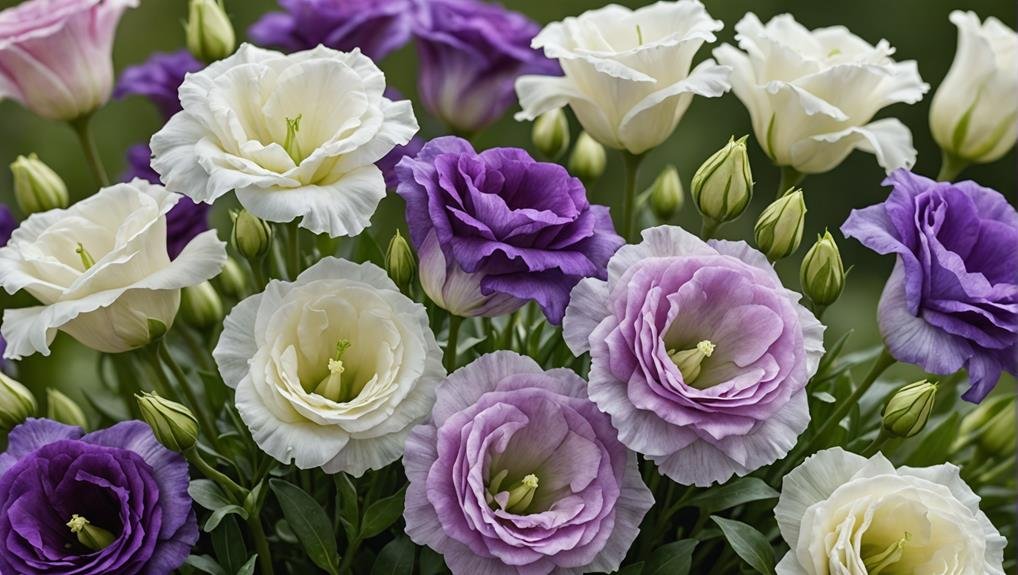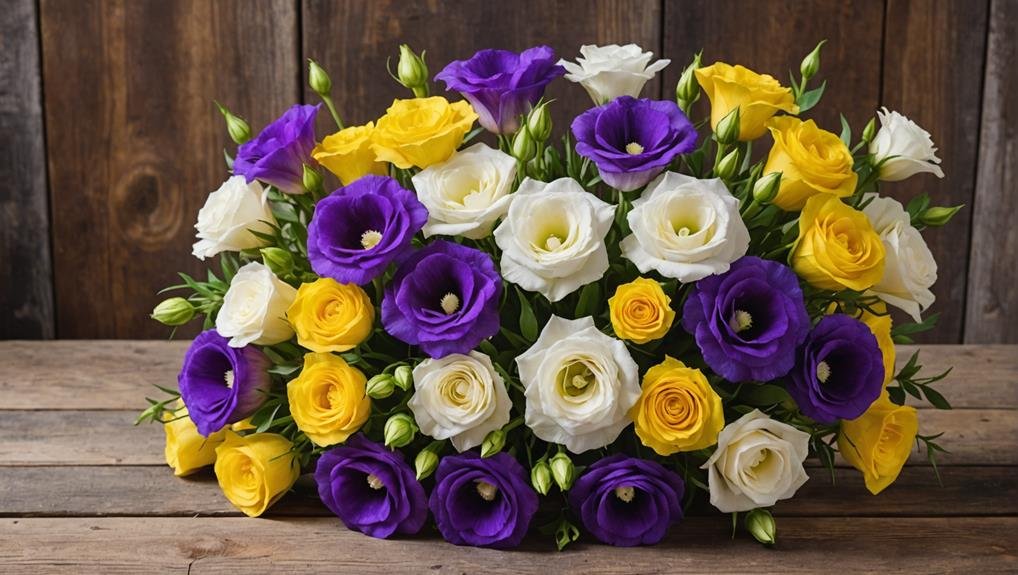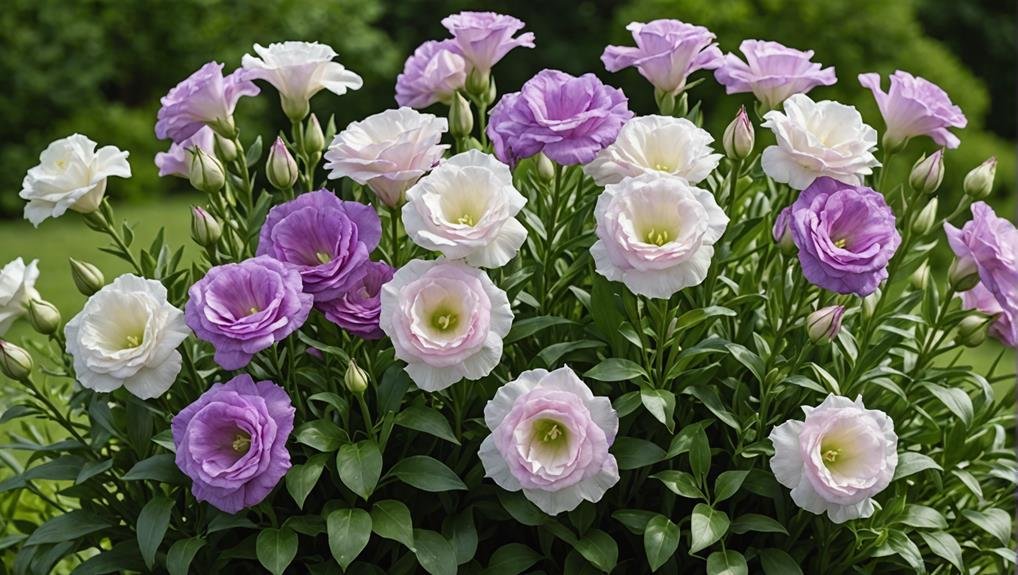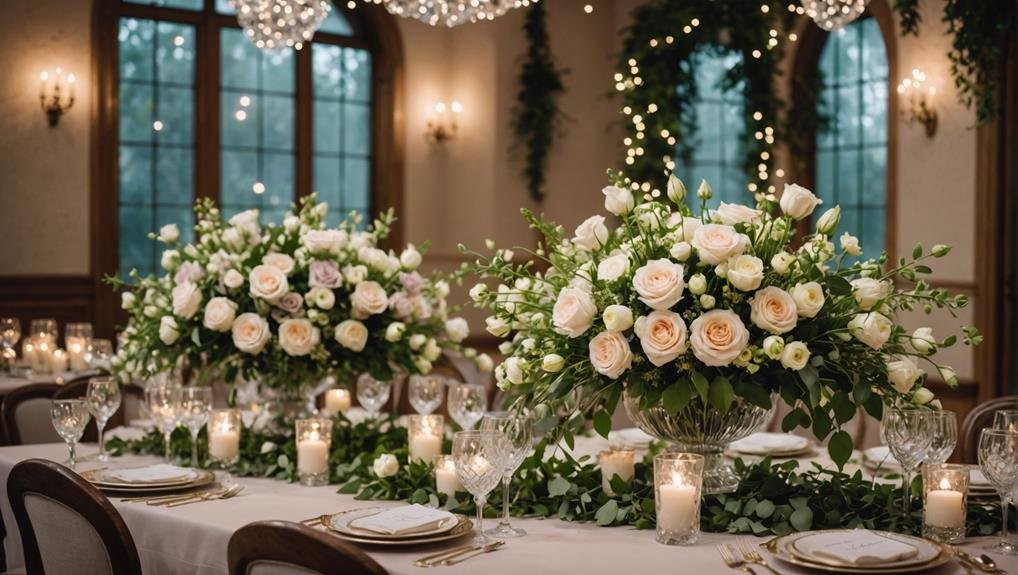When it comes to selecting wedding flowers that exude both elegance and versatility, Lisianthus stands out as an exceptional choice. Known for its delicate, trumpet-shaped blooms that come in a spectrum of soothing colors—ranging from peach to lavender—this flower can seamlessly enhance both bridal bouquets and centerpieces. Beyond its aesthetic appeal, Lisianthus is prized for its durability and year-round availability, making it a reliable option for weddings in any season. But what truly sets Lisianthus apart in the floral world? Let’s explore its unique characteristics and cultural significance further.
Flower Overview

Lisianthus flowers, known for their grace and elegance, are often referred to as Texas Bluebells or Prairie Gentians. These exquisite blooms are celebrated for their ability to convey sentiments of gratitude and appreciation, making them an ideal choice for wedding flowers. Their beautiful bloom exudes sophistication, which is why they are frequently selected for bridal bouquets.
The versatility of Lisianthus is one of its most enticing features. Available in a spectrum of colors, including peach, lavender, purple, pink, and white, they can seamlessly complement various wedding themes and color schemes. This wide array of hues allows brides to create personalized and visually enchanting bouquets that reflect their unique style and vision.
Moreover, Lisianthus flowers bloom throughout the year, providing a consistent supply for weddings regardless of the season. This year-round availability makes them a reliable option for wedding planners and florists. Their long stems and glossy green leaves add to their aesthetic appeal, offering a lush, full look to arrangements.
Physical Description
Characterized by their trumpet-shaped blooms with five fused petals, these flowers exhibit a striking resemblance to roses while offering greater durability. Lisianthus flowers, known for their elegant and refined appearance, are a popular choice for wedding arrangements due to their long-lasting nature and versatile beauty.
The structure of Lisianthus blooms is particularly remarkable. Each flower consists of five petals that are fused at the base, forming a distinctive trumpet shape. This unique configuration not only enhances their visual appeal but also contributes to their robustness, making them a hardy choice for various floral arrangements.
The petals themselves are delicate and silky, adding a touch of softness and sophistication to any bouquet or centerpiece.
In addition to their structural qualities, Lisianthus flowers come in various colors, ranging from pure white and soft pink to vibrant dark pink and rich purple. This wide spectrum of hues provides endless possibilities for creating stunning floral displays that can complement any wedding theme or color scheme.
The flowers’ ability to retain their freshness for an extended period, often lasting up to several weeks in a vase, further solidifies their status as a top choice for bridal bouquets and elegant centerpieces.
Available Colour Varieties

With a diverse palette including white, red, blue, yellow, pink, purple, and orange, the range of color variations of Lisianthus flowers offer unmatched flexibility for wedding floral arrangements. These vibrant color choices make Lisianthus a popular option among brides and florists, allowing for a seamless blend with different wedding themes and color palettes.
The presence of multicolored variations adds an extra touch of sophistication and distinctiveness to any bouquet. These varied Lisianthus hues can be combined to design romantic and customized bouquets that perfectly align with the couple’s vision for their special day.
Whether aiming for a traditional appearance with white and soft pink or a daring statement with rich purples and reds, there is a Lisianthus color choice to accommodate every preference.
Additionally, the adaptability of Lisianthus flowers extends to their capacity to complement or contrast with bridesmaid dresses, enhancing the overall look of the wedding party. The wide array of color choices available guarantees that each bouquet can be customized to mirror the unique style and character of the bride, making Lisianthus an excellent option for creating unforgettable and visually captivating wedding arrangements.
Latin Name and Taxonomy
Eustoma grandiflorum, commonly referred to as Lisianthus, belongs to the Gentianaceae family and is known for its striking, trumpet-shaped blooms. This exquisite flower is also recognized by other names such as Texas Bluebell and Prairie Gentian, reflecting its diverse regional ties and widespread appreciation.
The Lisianthus, or Eustoma grandiflorum, is distinguished by its elegant, five-petaled flowers, which are often found in a variety of enchanting colors including peach, lavender, purple, pink, and white. These blooms are not only visually appealing but also offer a refined touch to floral arrangements, making them a popular choice for weddings and other special occasions.
In terms of taxonomy, Eustoma grandiflorum is categorized within the Gentianaceae family, a group known for its ornamental plants. The genus Eustoma is derived from Greek, meaning ‘beautiful mouth,’ an apt description for its aesthetically pleasing flowers. The species name, grandiflorum, translates to ‘large flower,’ highlighting the plant’s impressive bloom size.
Lisianthus is highly valued in the floral industry for its versatility and lasting beauty, making it an exceptional choice for bouquets and centerpieces. Understanding its Latin name and taxonomy offers deeper insight into its botanical significance and enduring popularity.
Geographical Origins

Native to the warm regions of the southern United States, Mexico, the Caribbean, and South America, Lisianthus flourishes in environments with full sun exposure and well-drained soil. This versatile flower, also known by its scientific name Eustoma, has adapted well to these climates, making it a popular choice for various floral arrangements, particularly in weddings.
Lisianthus has gained significant popularity in the floral industry due to its delicate, rose-like appearance and wide range of colors. Its adaptability to different climates has facilitated its commercial cultivation in several countries beyond its native regions. Notable among these are the United States, Japan, the Netherlands, and Colombia, where advanced greenhouse techniques enable year-round production.
This commercial cultivation guarantees a steady supply of Lisianthus, meeting the high demand for this flower in the global market. The flower’s ability to thrive in diverse climates highlights its resilience and versatility, making it a favorite among florists and event planners worldwide.
As a result, Lisianthus has become a staple in wedding bouquets, centerpieces, and other decorative floral arrangements, celebrated for its beauty and enduring elegance.
Season Availability
Lisianthus flowers offer year-round availability, making them an ideal choice for weddings in any season. This perennial favorite thrives in moderate temperatures, ensuring that it is not restricted by specific seasonal availability.
Regardless of whether a wedding is planned for the vibrant days of summer, the rich hues of fall, the crisp chill of winter, or the fresh blossoms of spring, lisianthus can seamlessly be incorporated into floral arrangements.
The consistent year-round availability of lisianthus not only facilitates seamless planning but also enhances design flexibility. Brides and floral designers can rely on these elegant blooms to add a touch of sophistication to bouquets, centerpieces, and other decorative elements, irrespective of the season.
This versatility allows for creative expression in floral design, ensuring that each arrangement can be tailored to suit the unique aesthetic of the wedding, regardless of when it takes place.
Growing Conditions

To nurture these flowers successfully, make sure they receive full sunlight to partial shade and are planted in well-drained soil. Lisianthus, a popular choice for wedding arrangements, thrives under specific growing conditions that guarantee strong blooms and healthy plants.
These flowers prefer environments where they can bask in full sunlight for a significant portion of the day, although they can tolerate partial shade, especially in hotter climates.
Ideal growing conditions for Lisianthus include well-drained soil, which prevents waterlogging and root rot. Regular watering is essential, but it is important to maintain a balance to avoid overwatering. The perfect temperature range for Lisianthus cultivation spans from 50 to 85°F, making them suitable for a variety of climates.
Lisianthus is particularly resistant to pests and diseases when grown in ideal conditions, reducing the need for chemical interventions and ensuring a healthy growing environment. These versatile flowers can be cultivated in containers or garden beds, offering flexibility for different gardening setups.
Whether in a garden or a pot, following these growing conditions will yield the best results, providing stunning blooms perfect for wedding decor.
Cultural Significance
Embodying grace and elegance, the cultural significance of lisianthus spans across various traditions and celebrations, making it a cherished flower in wedding ceremonies. Known by various names such as Texas Bluebell and Prairie Gentian, lisianthus is celebrated for its refined beauty and profound symbolism.
This exquisite flower represents attributes such as grace, elegance, gratitude, charm, and appreciation in many cultures, making it a fitting choice for commemorative occasions.
Lisianthus’s cultural importance extends beyond mere aesthetics; it symbolizes love, happiness, and continuity, which are cornerstone themes in marriage ceremonies. Its delicate petals and sophisticated appearance resonate with the ideals of beauty and sophistication, enhancing the ambiance of any event it graces. This inherent symbolism makes lisianthus a meaningful addition to numerous cultural and traditional celebrations, where its presence is often seen as a blessing.
In various regions, the flower’s association with elegance and charm renders it a popular choice for expressing heartfelt emotions. Whether as a token of appreciation or a symbol of enduring love, lisianthus carries a depth of meaning that transcends its visual appeal, solidifying its role in significant life events.
Typical Use in Weddings

In wedding arrangements, lisianthus flowers are frequently chosen for their ability to add height, elegance, and visual interest to bouquets, centerpieces, and other decorative elements. Their versatility makes them a perfect wedding flower, seamlessly fitting into various decorative aspects such as arches, chuppahs, and ceremony urns. A variety of lisianthus can be found in wedding bouquets, where their delicate petals and rich colors create a beautiful and cohesive look.
Lisianthus flowers are also popular in boutonnieres and corsages, offering a refined touch that complements the overall wedding theme. They make stunning aisle decorations, reception flowers, and table arrangements, enhancing the aesthetic appeal of the venue. Additionally, lisianthus can be used to craft unique elements such as flower lanterns, crowns, toss bouquets, and hair flowers, adding a personalized touch to the wedding decor.
Below is a table summarizing the typical uses of lisianthus in weddings:
| Wedding Element | Usage | Benefits |
|---|---|---|
| Wedding Bouquet | Main flowers or fillers | Adds elegance and color variety |
| Centerpieces | Primary or accent flowers | Enhances visual interest |
| Boutonnieres & Corsages | Single blooms or small clusters | Offers a refined, cohesive look |
| Aisle Decorations | Arrangements along the aisle | Creates a beautiful pathway |
| Hair Flowers & Crowns | Individual blooms or small clusters | Adds a personalized, delicate touch |
Alternative Flower Types
Many couples seek alternative flower types for their weddings to create unique and personalized floral arrangements. Lisianthus stands out as an excellent choice, but there are other flowers that can offer similar benefits in terms of versatility, durability, and aesthetic appeal.
Here are four alternative flower types for a DIY wedding or event:
- Ranunculus: Known for their layered petals and vibrant colors, Ranunculus flowers can complement a wide range of wedding themes. They are perfect for adding texture and depth to bouquets and centerpieces.
- Anemones: With their striking black centers and bold colors, Anemones add a modern touch to wedding arrangements. Their unique appearance can serve as a focal point in floral designs or blend seamlessly with other blooms.
- Dahlias: Available in various shapes and sizes, Dahlias offer a rich palette of colors that can enhance any wedding decor. Their intricate petals and large blooms make them ideal for statement pieces.
- Astilbe: These feathery flowers bring a soft, romantic feel to arrangements. Astilbe’s subtle colors can effectively complement other flowers, making them a versatile choice for bridal bouquets and centerpieces.
Choosing the right alternative flower types can enhance the overall aesthetic of your special day, ensuring a memorable and beautiful celebration.
